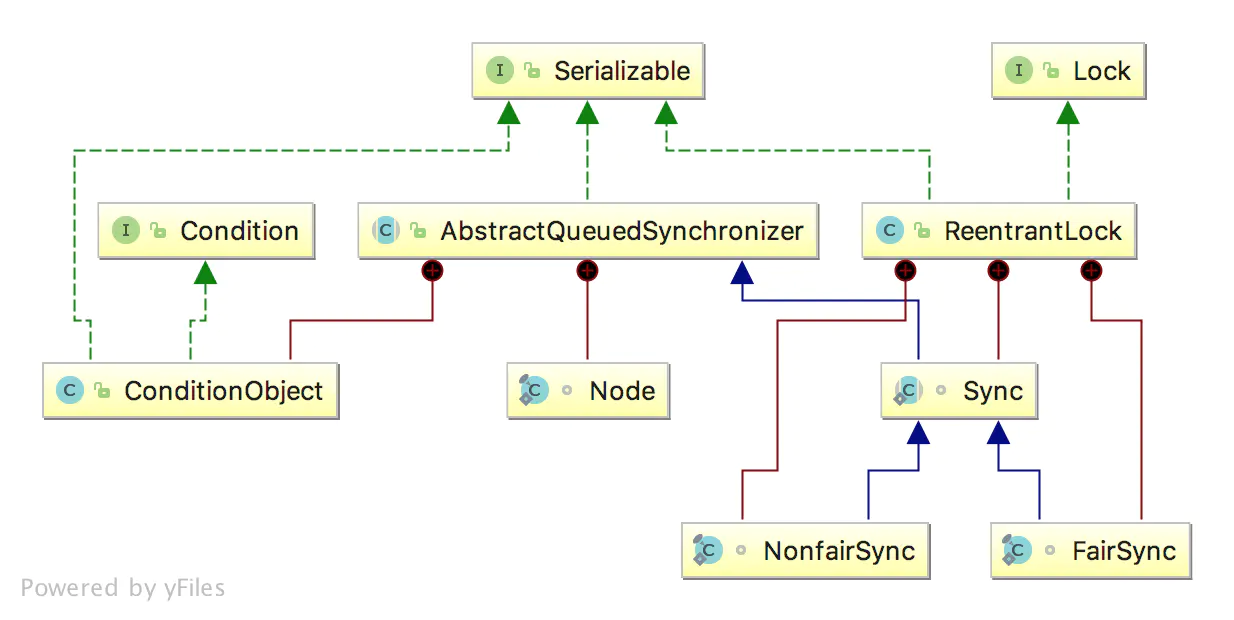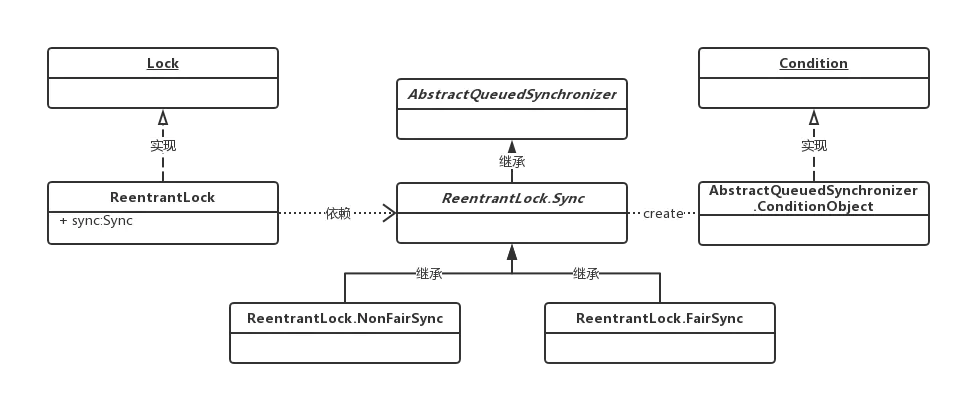ReentrantLock 详解
可独占,可重入,可中断,可公平可非公平。
引自掘金hahaeee (opens new window)和薛8 (opens new window)糅合而来。
# 主要特性:
可重入。ReentrantLock 是可重入锁,因为它会记录之前获得锁线程对象,保存在 exclusiveOwenerThread 变量中,当一个线程要获取锁时,会先判断当前线程是不是已经获取锁的线程。synchronized 也是可重入锁。
可中断。ReentrantLock 是可中断锁,它提供了 lockInterruptibly 这种可中断的加锁方式,可以有效的避免线程之间因为互相持续占有资源而导致阻塞。synchronized 无法实现可中断。
公平锁与非公平锁可选。ReentrantLock 默认是非公平锁,但是也可以通过构造方法选择非公平锁。公平锁是指当多个线程尝试获取同一个锁时,获取锁的顺序按照到达的时间顺序排序。


斜体为抽象类,下横线为接口
聚合关系总结:
- ReentrantLock 实现了 Lock,Serializable 接口
- ReentrantLock.Sync (内部类) 继承了 AQS
- ReentrantLock.NonfairSync 和 ReentrantLock.FairSync 继承了 ReentrantLock.Sync
- ReentrantLock 持有 ReentrantLock.Sync 对象 (实现锁功能)
锁实现总结:
- 由 Node 节点组成一条同步队列 (有 head,tail 两个指针,并且 head 初始化时指向空节点)
- int state 标记锁使用数量 (独占锁时,通常为 1, 发生重入时> 1)
- lock () 时加到队列尾部
- unlock () 时,释放 head 节点,并指向下一个节点 head=head.next, 然后唤醒当前 head 节点
性质:
- 独占锁 (排它锁): 只能有一个线程获取锁
- 重入锁:一个线程可以多次 lock ()
- 公平 / 非公平锁:只针对上锁过程
- 非公平锁:尝试获取锁,若成功立刻返回,失败则加入同步队列
- 公平锁:直接加入同步队列
# Lock
Lock 接口定义了锁的行为
public interface Lock {
//上锁(不响应Thread.interrupt()直到获取锁)
void lock();
//上锁(响应Thread.interrupt())
void lockInterruptibly() throws InterruptedException;
//尝试获取锁(以nonFair方式获取锁)
boolean tryLock();
//在指定时间内尝试获取锁(响应Thread.interrupt(),支持公平/二阶段非公平)
boolean tryLock(long time, TimeUnit unit) throws InterruptedException;
//解锁
void unlock();
//获取Condition
Condition newCondition();
}
2
3
4
5
6
7
8
9
10
11
12
13
14
# lock() 过程
//锁具体实现
private final Sync sync;
//根据传入参数选择FairSync或NonfairSync实现
public ReentrantLock(boolean fair) {
sync = fair ? new FairSync() : new NonfairSync();
}
public void lock() {
sync.lock();
}
#java.util.concurrent.locks.ReentrantLock.Sync
abstract void lock();
2
3
4
5
6
7
8
9
10
11
# 公平锁
加入同步队列 (当同步队列为空时会直接获得锁), 等待锁
#java.util.concurrent.locks.ReentrantLock.FairSync
final void lock() {
acquire(1);
}
#java.util.concurrent.locks.AbstractQueuedSynchronizer
public final void acquire(int arg) {
if (!tryAcquire(arg) &&acquireQueued(addWaiter(Node.EXCLUSIVE), arg))
selfInterrupt();
}
2
3
4
5
6
7
8
9
acquire () 流程:
tryAcquire (): 模板方法,获取锁
#java.util.concurrent.locks.ReentrantLock.FairSync protected final boolean tryAcquire(int acquires) { //获取当前线程 final Thread current = Thread.currentThread(); int c = getState(); if (c == 0) {//当前锁没被占用 if (!hasQueuedPredecessors() &&//1.判断同步队列中是否有节点在等待 compareAndSetState(0, acquires)) {//2.如果上面!1成立,修改state值(表明当前锁已被占用) setExclusiveOwnerThread(current);//3.如果2成立,修改当前占用锁的线程为当前线程 return true; } } else if (current == getExclusiveOwnerThread()) {//占用锁线程==当前线程(重入) int nextc = c + acquires;// if (nextc < 0) throw new Error("Maximum lock count exceeded"); setState(nextc);//修改status return true; } return false;//直接获取锁失败 }1
2
3
4
5
6
7
8
9
10
11
12
13
14
15
16
17
18
19
20
21acquireQueued (addWaiter (Node.EXCLUSIVE), arg): 加入同步队列
#java.util.concurrent.locks.AbstractQueuedSynchronizer //1 private Node addWaiter(Node mode) { //生成node Node node = new Node(Thread.currentThread(), mode); Node pred = tail; if (pred != null) { //将node加到队列尾部 node.prev = pred; if (compareAndSetTail(pred, node)) { pred.next = node; return node; } } //如果加入失败(多线程竞争或者tail指针为null) enq(node); return node; } //1.1 private Node enq(final Node node) { //死循环加入节点(cas会失败) for (;;) { Node t = tail; if (t == null) { //tail为null,同步队列初始化 //设置head指针 if (compareAndSetHead(new Node()))//注意这里是个空节点!! tail = head;//将tail也指向head } else { node.prev = t;//将当前node加到队尾 if (compareAndSetTail(t, node)) { t.next = node; return t;//注意这里才返回 } } } } //2 final boolean acquireQueued(final Node node, int arg) { boolean failed = true; try { //表示是否被打断 boolean interrupted = false; for (;;) { //获取node.pre节点 final Node p = node.predecessor(); if (p == head //当前节点是否是同步队列中的第二个节点 && tryAcquire(arg)) {//获取锁,head指向当前节点 setHead(node);//head=head.next p.next = null;//置空 failed = false; return interrupted; } if (shouldParkAfterFailedAcquire(p, node) && //是否空转(因为空转唤醒是个耗时操作,进入空转前判断pre节点状态.如果pre节点即将释放锁,则不进入空转) parkAndCheckInterrupt())//利用unsafe.park()进行空转(阻塞) interrupted = true;//如果Thread.interrupt()被调用,(不会真的被打断,会继续循环空转直到获取到锁) } } finally { if (failed)//tryAcquire()过程出现异常导致获取锁失败,则移除当前节点 cancelAcquire(node); } }1
2
3
4
5
6
7
8
9
10
11
12
13
14
15
16
17
18
19
20
21
22
23
24
25
26
27
28
29
30
31
32
33
34
35
36
37
38
39
40
41
42
43
44
45
46
47
48
49
50
51
52
53
54
55
56
57
58
59
60
61
62过程总结:
- 空转 (如果当前节点是同步队列中的第二个节点,则直接获得锁返回)
- 获得锁
注意,这里有两次tryAcquire()过程:
第一次,为了避免同步队列为空时还插入队列产生的性能耗费(cas空转)。
第二次,就是正常的流程,先插入队尾,然后等待唤醒,再获取锁。selfInterrupt (): 唤醒当前线程
static void selfInterrupt() {//在获取锁之后 响应intterpt()请求 Thread.currentThread().interrupt(); }1
2
3
# 非公平锁
一阶段
#java.util.concurrent.locks.ReentrantLock.NonfairSync
final void lock() {
//在acquire()之前先尝试获取锁
if (compareAndSetState(0, 1))
setExclusiveOwnerThread(Thread.currentThread());
else
acquire(1);
}
2
3
4
5
6
7
8
二阶段 acquire () 流程与公平锁一模一样,唯一区别在于 tryAcquire () 实现中
#java.util.concurrent.locks.ReentrantLock.NonfairSync
protected final boolean tryAcquire(int acquires) {
return nonfairTryAcquire(acquires);
}
#java.util.concurrent.locks.ReentrantLock.Sync
final boolean nonfairTryAcquire(int acquires) {//这个过程其实和FairSync.tryAcquire()基本一致
final Thread current = Thread.currentThread();
int c = getState();
if (c == 0) {
//唯一区别: 这里不会去判断队列中是否为空
if (compareAndSetState(0, acquires)) {
setExclusiveOwnerThread(current);
return true;
}
}
else if (current == getExclusiveOwnerThread()) {
int nextc = c + acquires;
if (nextc < 0) // overflow
throw new Error("Maximum lock count exceeded");
setState(nextc);
return true;
}
return false;
}
2
3
4
5
6
7
8
9
10
11
12
13
14
15
16
17
18
19
20
21
22
23
24
25
| 区别点 | lock () 过程 (一阶段) | tryAcquire () 过程 (二阶段) |
|---|---|---|
| FairSync | 直接 acquire () | 当前若无线程持有锁,如果同步队列为空,获取锁 |
| NonFairSync | 先尝试获取锁,再 acquire () | 当前若无线程持有锁,获取锁 |
# unlock() 过程
#java.util.concurrent.locks.ReentrantLock
public void unlock() {
sync.release(1);
}
#java.util.concurrent.locks.AbstractQueuedSynchronizer
public final boolean release(int arg) {
if (tryRelease(arg)) {//释放锁
Node h = head;
if (h != null &&//head节点为空(非公平锁直接获取锁)
h.waitStatus != 0)
unparkSuccessor(h);//唤醒同步队列中离head最近的一个waitStatus<=0的节点
return true;
}
return false;
}
#java.util.concurrent.locks.ReentrantLock
protected final boolean tryRelease(int releases) {
int c = getState() - releases;
//持有锁的线程==当前线程
if (Thread.currentThread() != getExclusiveOwnerThread())
throw new IllegalMonitorStateException();
boolean free = false;
if (c == 0) {//重入锁全部释放
free = true;
//置空持有锁线程
setExclusiveOwnerThread(null);
}
//state==0(此时持有锁,不用cas)
setState(c);
return free;
}
2
3
4
5
6
7
8
9
10
11
12
13
14
15
16
17
18
19
20
21
22
23
24
25
26
27
28
29
30
31
# lockInterruptibly() 中断锁过程
lockInterruptibly () 与 lock () 过程基本相同,区别在于 Thread.intterpt () 的应对措施不同。
ReentrantLock 中的 lockInterruptibly () 方法使得线程可以在被阻塞时响应中断,比如一个线程 t1 通过 lockInterruptibly() 方法获取到一个可重入锁,并执行一个长时间的任务,另一个线程通过 lockInterruptibly() 方法就可以立刻打断 t1 线程的执行,来获取 t1 持有的那个可重入锁。而通过 ReentrantLock 的 lock () 方法或者 Synchronized 持有锁的线程是不会响应其他线程的 interrupt () 方法的,直到该方法主动释放锁之后才会响应 interrupt () 方法。
//lock()
final boolean acquireQueued(final Node node, int arg) {
boolean failed = true;
try {
//表示是否被打断
boolean interrupted = false;
for (;;) {
//获取node.pre节点
final Node p = node.predecessor();
if (p == head //当前节点是否是同步队列中的第二个节点
&& tryAcquire(arg)) {//获取锁,当前head指向当前节点
setHead(node);//head=head.next
p.next = null;//置空
failed = false;
return interrupted;
}
if (shouldParkAfterFailedAcquire(p, node) && //是否空转(因为空转唤醒是个耗时操作,进入空转前判断pre节点状态.如果pre节点即将释放锁,则不进入空转)
parkAndCheckInterrupt())//利用unsafe.park()进行空转(阻塞)
interrupted = true;//如果Thread.interrupt()被调用,(不会真的被打断,会继续循环空转直到获取到锁)
}
} finally {
if (failed)//tryAcquire()过程出现异常导致获取锁失败,则移除当前节点
cancelAcquire(node);
}
}
// lockInterruptibly()
private void doAcquireInterruptibly(int arg)
throws InterruptedException {
final Node node = addWaiter(Node.EXCLUSIVE);
boolean failed = true;
try {
for (;;) {
final Node p = node.predecessor();
if (p == head && tryAcquire(arg)) {
setHead(node);
p.next = null;
failed = false;
return;
}
if (shouldParkAfterFailedAcquire(p, node) &&
parkAndCheckInterrupt())//唯一区别当Thread.intterpt()打断时,直接抛出异常
throw new InterruptedException();
}
} finally {
if (failed)//然后移除当前节点
cancelAcquire(node);
}
}
2
3
4
5
6
7
8
9
10
11
12
13
14
15
16
17
18
19
20
21
22
23
24
25
26
27
28
29
30
31
32
33
34
35
36
37
38
39
40
41
42
43
44
45
46
47
48
49
- 中断锁代码测试:CSDN (opens new window)
# tryLock()
#java.util.concurrent.locks.ReentrantLock
public boolean tryLock() {
//尝试获取非公平锁
return sync.nonfairTryAcquire(1);
}
2
3
4
5
# tryLock(long timeout, TimeUnit unit)
#java.util.concurrent.locks.ReentrantLock
public boolean tryLock(long timeout, TimeUnit unit)
throws InterruptedException {
return sync.tryAcquireNanos(1, unit.toNanos(timeout));
}
#java.util.concurrent.locks.AbstractQueuedSynchronizer
public final boolean tryAcquireNanos(int arg, long nanosTimeout)
throws InterruptedException {
if (Thread.interrupted())
throw new InterruptedException();
return tryAcquire(arg) ||//获取锁(公平/非公平)
doAcquireNanos(arg, nanosTimeout);//在指定时间内等待锁(空转)
}
private boolean doAcquireNanos(int arg, long nanosTimeout)
throws InterruptedException {
...
final long deadline = System.nanoTime() + nanosTimeout;
//加入队尾
final Node node = addWaiter(Node.EXCLUSIVE);
boolean failed = true;
try {
for (;;) {
final Node p = node.predecessor();
if (p == head && tryAcquire(arg)) {
setHead(node);
p.next = null;
failed = false;
return true;
}
//上面与acquireQueued()相同,重点看这里
//计算剩余时间
nanosTimeout = deadline - System.nanoTime();
if (nanosTimeout <= 0L)
return false;
if (shouldParkAfterFailedAcquire(p, node) &&
nanosTimeout > spinForTimeoutThreshold)
//利用parkNanos()指定空转时间
LockSupport.parkNanos(this, nanosTimeout);
if (Thread.interrupted())//如果被Thread.interrupt(),则抛异常
throw new InterruptedException();
}
} finally {
if (failed)//移除节点
cancelAcquire(node);
}
}
2
3
4
5
6
7
8
9
10
11
12
13
14
15
16
17
18
19
20
21
22
23
24
25
26
27
28
29
30
31
32
33
34
35
36
37
38
39
40
41
42
43
44
45
46
47
# ReentrantLock 的等待 / 通知机制
# newCondition()
public Condition newCondition() {
return sync.newCondition();
}
#java.util.concurrent.locks.ReentrantLock.Sync
final ConditionObject newCondition() {
return new ConditionObject();
}
2
3
4
5
6
7
- 等待和唤醒
我们知道关键字 Synchronized + Object 的 wait 和 notify、notifyAll 方法能实现等待 / 通知机制,那么 ReentrantLock 是否也能实现这样的等待 / 通知机制,答案是:可以。
ReentrantLock 通过 Condition 对象,也就是条件队列实现了和 wait、notify、notifyAll 相同的语义。 线程执行 condition.await() 方法,将节点 1 从同步队列转移到条件队列中。

线程执行 condition.signal() 方法,将节点 1 从条件队列中转移到同步队列。

因为只有在同步队列中的线程才能去获取锁,所以通过 Condition 对象的 wait 和 signal 方法能实现等待 / 通知机制。
- 等待和唤醒部分
如果想单独唤醒部分线程应该怎么做呢?这时就有必要使用多个 Condition 对象了,因为 ReentrantLock 支持创建多个 Condition 对象,例如:
//为了减少篇幅 仅给出伪代码
ReentrantLock lock = new ReentrantLock();
Condition condition = lock.newCondition();
Condition condition1 = lock.newCondition();
//线程1 调用condition.await() 线程进入到条件队列
condition.await();
//线程2 调用condition1.await() 线程进入到条件队列
condition1.await();
//线程32 调用condition.signal() 仅唤醒调用condition中的线程,不会影响到调用condition1。
condition1.await();
2
3
4
5
6
7
8
9
10
11
12
13
这样就实现了部分唤醒的功能。
# ReentrantLock 和 Synchronized 对比
| ReentrantLock | Synchronized | |
|---|---|---|
| 底层实现 | 通过 AQS 实现 | 通过 JVM 实现,其中 synchronized 又有多个类型的锁,除了重量级锁是通过 monitor 对象 (操作系统 mutex 互斥原语) 实现外,其它类型的通过对象头实现。 |
| 是否可重入 | 是 | 是 |
| 公平锁 | 是 | 否 |
| 非公平锁 | 是 | 是 |
| 锁的类型 | 悲观锁、显式锁 | 悲观锁、隐式锁 (内置锁) |
| 是否支持中断 | 是 | 否 |
| 是否支持超时等待 | 是 | 否 |
| 是否自动获取 / 释放锁 | 否 | 是 |